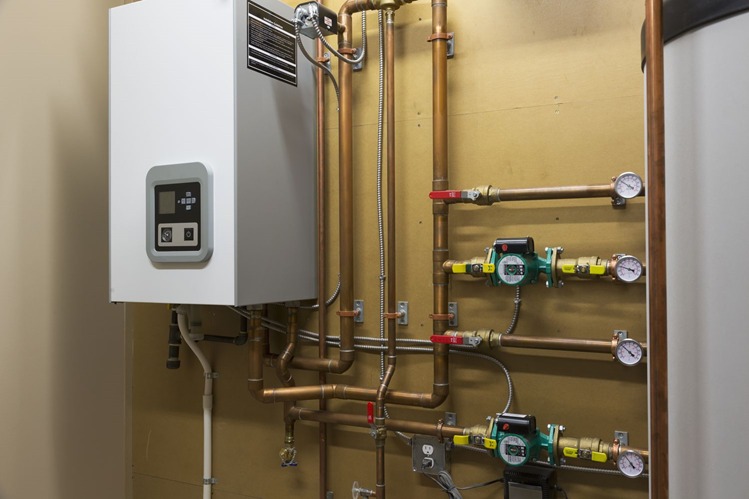In recent years, the demand for efficient and eco-friendly home appliances has surged, leading many homeowners to explore advanced solutions for their everyday needs. One such innovation gaining widespread attention is the tankless hot water system. Unlike traditional water heaters that store a large volume of water in a tank, a tankless hot water system heats water on demand, providing hot water instantly whenever needed.
The concept is simple yet revolutionary: as water flows through the unit, it is heated by an electric element or gas burner, eliminating the need for a storage tank. This on-demand heating method ensures a continuous supply of hot water, which is particularly beneficial for larger households or homes with high hot water consumption.
Switching to a tankless hot water system comes with numerous advantages. The most notable benefit is the significant improvement in energy efficiency. Traditional water heaters are constantly working to maintain the temperature of the stored water, leading to energy wastage. In contrast, tankless systems only use energy when hot water is required, resulting in lower utility bills and a reduced carbon footprint.
Additionally, tankless systems are known for their compact size. Without the bulky tank, they free up valuable space in your home, offering more flexibility in installation locations. Whether you’re looking to maximize your storage space or seeking a sleek, modern alternative to traditional water heaters, a tankless hot water system is an excellent choice.
As more homeowners recognize the benefits of this technology, tankless hot water systems are becoming a standard upgrade in home renovations. In the following sections, we will delve deeper into the specific advantages, considerations for upgrading, and tips for installation and maintenance to help you make an informed decision about adopting this innovative water heating solution.
Advantages of Tankless Hot Water Systems
Upgrading to a tankless hot water system offers several compelling benefits that make it a smart choice for modern households. Here are some of the key advantages that set tankless systems apart from traditional tank-based water heaters:
1. Energy Efficiency and Cost Savings
One of the most significant advantages of a tankless hot water system is its superior energy efficiency. Traditional water heaters continuously heat and reheat water to maintain a set temperature, leading to substantial energy waste. In contrast, tankless systems only heat water as needed, reducing energy consumption by up to 30%. This on-demand heating can translate to noticeable savings on your monthly utility bills, making the initial investment in a tankless system more economical in the long run.
2. Continuous Hot Water Supply
With a tankless hot water system, you’ll never run out of hot water. Traditional tank-based heaters can deplete their hot water supply, especially during periods of high demand, leaving you waiting for the tank to refill and reheat. Tankless systems eliminate this issue by providing an endless stream of hot water, ensuring that every family member can enjoy a hot shower, even during peak usage times.
3. Space-Saving Design
The compact design of tankless hot water systems is another significant benefit. Traditional water heaters with large storage tanks require considerable space for installation. In contrast, tankless systems are small and can be mounted on walls, freeing up valuable floor space in your utility room, basement, or garage. This space-saving feature is particularly advantageous for homes with limited storage areas.
4. Longevity and Durability
Tankless hot water systems typically have a longer lifespan compared to traditional water heaters. While tank-based heaters usually last around 10-15 years, tankless systems can last up to 20 years or more with proper maintenance. Their durable construction and fewer parts susceptible to corrosion and wear contribute to their extended service life. This longevity means fewer replacements and less frequent maintenance, offering you greater peace of mind and long-term savings.
5. Environmentally Friendly
By reducing energy consumption, tankless hot water systems also contribute to a lower carbon footprint. The efficiency of these systems means they require less fuel to operate, whether powered by electricity or gas, resulting in fewer greenhouse gas emissions—especially given the current natural gas rates GA. Choosing a tankless system is a step towards a more sustainable and eco-friendly home.
These advantages highlight why many homeowners are making the switch to tankless hot water systems. Their energy efficiency, continuous hot water supply, space-saving design, durability, and environmental benefits make them a superior choice for modern water heating needs. In the next section, we will discuss the factors you should consider before upgrading to ensure that a tankless hot water system is the right fit for your home.
Factors to Consider Before Upgrading
While the benefits of upgrading to a tankless hot water system are clear, it’s essential to evaluate several key factors before making the switch. Understanding these considerations will help ensure that the system you choose meets your household’s needs and provides the expected efficiency and performance.
1. Initial Costs and Installation Requirements
The initial cost of purchasing and installing a tankless hot water system can be higher than that of traditional tank-based water heaters. This includes the price of the unit itself and the installation fees, which can vary depending on the complexity of the setup. Factors such as the need for new gas lines, venting, or electrical upgrades can add to the installation cost. However, these upfront expenses are often offset by the long-term energy savings and the extended lifespan of the tankless system.
2. Sizing the System for Your Home
Choosing the right size tankless hot water system is crucial for ensuring adequate hot water supply. Tankless systems are rated by their maximum flow rate, measured in gallons per minute (GPM), and the temperature rise they can achieve. To select the appropriate system, you need to calculate your household’s peak hot water demand and ensure the system can handle that load. Consulting with a professional installer can help you accurately size the system based on the number of fixtures and appliances that will simultaneously use hot water.
3. Compatibility with Existing Plumbing and Electrical Systems
Before upgrading, it’s important to assess your home’s existing plumbing and electrical systems for compatibility with a tankless hot water system. Tankless systems may require larger gas lines or higher voltage electrical circuits than what is currently in place. Additionally, proper venting is essential for gas-powered units to ensure safe operation. An experienced installer can evaluate your home’s infrastructure and recommend any necessary modifications to accommodate the new system.
4. Maintenance and Servicing Needs
While tankless hot water systems generally require less maintenance than traditional tank-based heaters, they are not entirely maintenance-free. Regular descaling is necessary, especially in areas with hard water, to prevent mineral buildup that can reduce efficiency and lifespan. It’s also important to periodically check and clean the system’s filters and ensure that the venting system remains clear. Understanding the maintenance requirements and scheduling regular servicing can help keep your tankless system running efficiently for many years.
5. Warranty and Support
Review the warranty and support options offered by the manufacturer of the tankless hot water system you are considering. A comprehensive warranty can provide peace of mind and protect your investment against defects and issues. Additionally, ensure that there are local service providers who are experienced with tankless systems and can offer prompt support if needed.
Also Read : Wedding Gifts
Installation Process and Tips
Upgrading to a tankless hot water system involves several steps and considerations to ensure a successful installation. Whether you decide to hire a professional or take on the project yourself, understanding the installation process and following best practices will help you achieve optimal performance and efficiency from your new system.
1. Hiring a Professional vs. DIY Installation
While some homeowners with advanced plumbing and electrical skills may choose to install a tankless hot water system themselves, hiring a professional is often the recommended route. Professional installers have the expertise to handle the complexities of the job, including ensuring proper gas line sizing, electrical requirements, and venting. Additionally, professional installation typically includes a warranty on the labor, providing extra peace of mind.
2. Necessary Permits and Regulations
Before installation, check with your local building department to determine if any permits are required. Building codes and regulations vary by location, and compliance is essential to ensure safety and avoid potential fines. A professional installer will be familiar with local codes and can help secure the necessary permits. Ensuring that your installation meets all regulatory requirements is critical for the safe and efficient operation of your tankless hot water system.
3. Installation Timeline and What to Expect
The installation timeline for a tankless hot water system can vary depending on the complexity of the job and any necessary modifications to your home’s infrastructure. Generally, the process involves the following steps:
- Site Assessment: The installer will evaluate your home’s plumbing, gas, and electrical systems to determine the best location for the unit and identify any necessary upgrades.
- Preparation: This may include running new gas lines or electrical circuits, installing venting, and making any necessary modifications to your plumbing system.
- Installation: The tankless unit is mounted, and all connections are made. The installer will test the system to ensure proper operation and check for leaks or other issues.
- Final Inspection: Once installed, the system may need to be inspected by a local building official to ensure compliance with codes and regulations.
4. Tips for Ensuring a Smooth Installation
To facilitate a smooth installation process, consider the following tips:
- Choose the Right Location: Select a location that minimizes the distance between the unit and the points of use to reduce heat loss and improve efficiency. The unit should also be easily accessible for maintenance.
- Prepare Your Home: Clear the area where the unit will be installed and ensure there is adequate space for the installer to work. Inform household members of the installation schedule to minimize disruptions.
- Communicate with Your Installer: Discuss any concerns or special requirements with your installer beforehand. Clear communication can help prevent misunderstandings and ensure the installation meets your expectations.
- Plan for Downtime: Be prepared for a temporary interruption in hot water supply during the installation process. Most installations can be completed within a day, but it’s wise to have contingency plans for any extended downtime.
By understanding the installation process and following these tips, you can ensure a successful upgrade to a tankless hot water system. Proper installation is crucial for achieving the system’s full benefits, including energy efficiency, continuous hot water supply, and longevity. In the next section, we will explore how to maximize the benefits of your new tankless hot water system through regular maintenance and optimization strategies.
Maximizing the Benefits of Your Tankless Hot Water System
Once you’ve successfully installed your tankless hot water system, it’s important to adopt best practices to maximize its benefits. Regular maintenance, optimal settings, and troubleshooting common issues will ensure your system operates efficiently and reliably for years to come.
1. Regular Maintenance Practices
Regular maintenance is crucial to keep your tankless hot water system running at peak performance. Here are some key maintenance tasks to perform:
- Descaling: Mineral buildup can reduce efficiency and damage the unit over time. Descaling, or flushing the system, should be done at least once a year, especially in areas with hard water. This process involves circulating a descaling solution through the unit to remove mineral deposits.
- Filter Cleaning: Many tankless systems have inlet water filters that can trap debris and sediment. These filters should be checked and cleaned periodically to maintain proper water flow and prevent clogs.
- Vent and Exhaust Inspection: For gas-powered systems, ensure the venting and exhaust systems are clear of obstructions and properly sealed. This prevents dangerous gas leaks and ensures efficient operation.
2. Optimizing System Settings for Efficiency
Optimizing your tankless hot water system’s settings can enhance efficiency and performance. Consider the following tips:
- Temperature Settings: Set the temperature to the recommended level, usually between 120°F and 140°F. Setting it too high can waste energy and increase the risk of scalding, while too low may not provide adequate hot water.
- Flow Rate Adjustments: Some systems allow you to adjust the flow rate. Setting the appropriate flow rate ensures you receive sufficient hot water without overloading the system.
- Recirculation Systems: If your tankless unit is equipped with a recirculation pump, use it wisely to ensure hot water is readily available without wasting energy.
3. Troubleshooting Common Issues
Even with regular maintenance, occasional issues may arise. Here are some common problems and their solutions:
- Fluctuating Water Temperature: If you experience inconsistent water temperatures, it could be due to mineral buildup or incorrect settings. Descaling the unit and checking the temperature settings can resolve this issue.
- Low Water Pressure: Low water pressure can be caused by clogged filters or pipes. Cleaning the filters and inspecting the plumbing for blockages can help restore proper pressure.
- Error Codes: Many tankless systems display error codes when there is a problem. Refer to the user manual to interpret these codes and follow the recommended steps to resolve the issue.
4. Enhancing Your Home’s Overall Water Heating Strategy
To fully benefit from your tankless hot water system, consider integrating it into a comprehensive water heating strategy for your home:
- Insulate Pipes: Insulating hot water pipes reduces heat loss and improves efficiency. This is particularly important for pipes running through unheated spaces.
- Reduce Hot Water Demand: Implement water-saving measures such as low-flow showerheads and faucets to reduce the overall demand for hot water, which can enhance the performance of your tankless system.
- Energy Audits: Periodically conduct an energy audit to identify areas where you can further improve energy efficiency in your home. This can help you optimize your tankless system’s performance and reduce overall energy consumption.
By following these practices, you can ensure your tankless hot water system operates efficiently and reliably, providing you with continuous hot water and long-term energy savings. Proper maintenance, optimal settings, and a holistic approach to water heating will help you make the most of your investment and enjoy the full benefits of this modern technology.
Conclusion
Upgrading to a tankless hot water system offers numerous benefits, including energy efficiency, continuous hot water supply, space-saving design, and long-term cost savings. By understanding the key advantages, assessing the factors to consider before upgrading, and following best practices during installation, you can ensure a smooth transition to this modern water heating solution.
Regular maintenance and optimization of your tankless system are essential to maximize its performance and longevity. By performing routine descaling, adjusting system settings for efficiency, and addressing common issues promptly, you can keep your tankless hot water system running at its best. Additionally, integrating your tankless unit into a comprehensive water heating strategy for your home can further enhance its benefits.
As more homeowners seek environmentally friendly and cost-effective solutions, tankless hot water systems are becoming an increasingly popular choice. By making an informed decision and investing in proper maintenance, you can enjoy the numerous advantages of a tankless hot water system, ensuring a reliable and efficient source of hot water for years to come.



